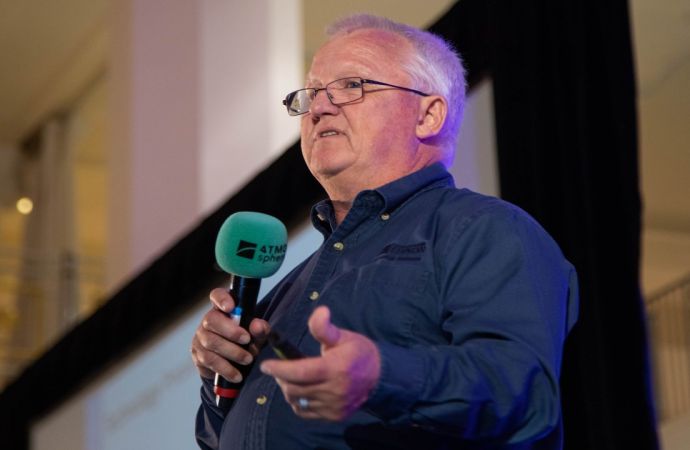Southern California Edison needs data from manufacturers on uptake of ammonia/CO2 cascade systems and air-cooled ammonia/water chillers.

Paul Delaney. Southern California Edison
Southern California Edison (SCE), the primary electric supply company for much of Southern California (U.S.), is seeking feedback from manufacturers, engineers and specifiers around the world about the uptake of low-charge ammonia (R717)/CO2 (R744) cascade refrigeration systems, and air-cooled ammonia/water chillers.
The survey results will be used by SCE to support custom incentives for these systems, said Paul Delaney, Senior Engineer at SCE, who is compiling the results.
The survey for each technology can be found below. Delaney encourages respondents to copy and paste the questions on a word document, answer the questions, and email the document to Paul.Delaney@sce.com.
Delaney noted that food/beverage processing and cold storage facilities in the U.S. and California have begun using low-charge ammonia/CO2 Cascade systems for “increased energy performance and simpler maintenance needs.” The low charge of ammonia, coupled with its segregation in the machine room, “allows the use of NH3 refrigerant in facilities of smaller size as well that would normally not consider NH3 systems.”
Low-charge ammonia/CO2 cascade technology has seen wide adoption in several European countries as well as Japan over the last seven to 10 years, noted Delaney “with several manufacturers having installed over 1,000 of these systems to date.” In addition, this technology can be used for many processing applications across temperatures ranging from -60 to 50°F (-51 to 10°C).
In a study done at a food processing facility in Southern California, an ammonia/CO2 system achieved an energy reduction of 31% compared to the existing R507a two-stage refrigeration system at the same facility.
Saving energy and water
An efficient, air-cooled chiller that uses a natural refrigerant such as ammonia provides several benefits to food processing facilities, including “reduced energy and water consumption along with the environmental aspect of a zero GWP refrigerant,” said Delaney. As a result, the use of these chillers has steadily increased over the last several years in the U.S., while being widely used in European and Asian Countries.
While there are new very low GWP synthetic HFO refrigerants now available, “there is still uncertainty on the long-term effects regarding human exposure and environmental impacts for these HFO refrigerants,” noted Delaney.
Air-cooled ammonia/water chillers employ microchannel air-cooled condensers for reduced ammonia charge along with microprocessor control strategy to optimize the condenser fan speed and compressor speed to match existing conditions more precisely.
Takara Sake USA, a producer of sake in Berkeley, California, achieved an energy reduction of 28% and water savings of 90% with an ammonia/water chiller compared to existing an R507a water chiller at the same facility.
Survey for Ammonia/CO2 Cascade System
(Copy and paste in word document and email with answers to Paul.Delaney@sce.com.)
Name:
Company:
Position:
Email:
Phone number:
1. How often have you sold systems that use Low Charge Ammonia/CO2 Cascade refrigeration technologies vs. other alternative process refrigeration systems to your customers within the last 12 months?
1. a. What would you recommend as the base (typical) proposal for process refrigeration systems today?
2. How often do customers select the Low Charge Ammonia/CO2 Cascade refrigeration systems vs. other types of process refrigeration systems within the last 12 months?
3. What is the likelihood that customers in this specific segment would purchase and install Low Charge Ammonia/CO2 Cascade refrigeration systems for process refrigeration applications today?
4. What are the reasons for and against purchasing and installing Low Charge Ammonia/CO2 Cascade refrigeration systems? Please share any experience that supports your reasons.
Survey for Air-Cooled Ammonia/Water Chillers
(Copy and paste in word document and email with answers to Paul.Delaney@sce.com.)
1. How often have you sold systems that use Air-Cooled Ammonia/Water chiller technologies vs. other alternative HFC and HFO refrigerant air-cooled water chillers to your chiller customers within the last 12 months?
1.a. What would you recommend as the base (typical) proposal for Air-Cooled Ammonia/Water chillers today?
2. How often do customers select the Air-Cooled Ammonia/Water chiller technologies vs. other air-cooled water chillers within the last 12 months?
3. What is the likelihood that customers in this specific segment would purchase and install Air-Cooled/Water chiller technologies for water chiller applications today?
4. What are the reasons for and against purchasing and installing Air-Cooled Ammonia/Water chiller technologies?Please share any experience that supports your reasons.
There is still uncertainty on the long-term effects regarding human exposure and environmental impacts for these HFO refrigerants."
– Paul Delaney, Southern California Edision
Related stories



